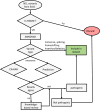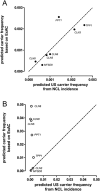Analysis of large-scale whole exome sequencing data to determine the prevalence of genetically-distinct forms of neuronal ceroid lipofuscinosis
- PMID: 27553520
- PMCID: PMC5505770
- DOI: 10.1016/j.gene.2016.08.031
Analysis of large-scale whole exome sequencing data to determine the prevalence of genetically-distinct forms of neuronal ceroid lipofuscinosis
Abstract
The neuronal ceroid lipofuscinoses (NCLs) are a group of fatal, mostly recessive neurodegenerative lysosomal storage diseases. While clinically similar, they are genetically distinct and result from mutations in at least twelve different genes. Estimates of NCL incidence range from 0.6 to 14 per 100,000 live births but vary widely between populations and are influenced by whether patients are classified based upon clinical or genetic criteria. We investigated mutations in twelve NCL genes in ~61,000 individuals represented in the Exome Aggregation Consortium (ExAC) whole exome sequencing database. Variants were extracted from ExAC and pathogenic alleles were differentiated from neutral polymorphisms using annotated variant databases and missense mutation prediction tools. Carrier frequency was dependent on ethnicity, with the highest (1/75) observed for PPT1 in the Finnish. When data are adjusted for ethnic diversity within the USA, PPT1, TPP1 and CLN3 carrier frequencies were found to be the highest of the NCLs, each at ~1/500. Carrier frequencies calculated from ExAC correlated well with incidence estimated from numbers of living NCL patients in the US. In addition, the analysis identified numerous variants that are annotated as pathogenic in public repositories but have a predicted frequency that is not consistent with patient studies. These variants appear to be neutral polymorphisms that are reported as pathogenic without validation. Based upon literature reports, such alleles may be annotated in public databases as pathogenic and this propagates errors that can have clinical consequences.
Keywords: Neuronal ceroid lipofuscinosis; Whole exome sequencing.
Copyright © 2016 Elsevier B.V. All rights reserved.
Figures


References
-
- Augestad LB, Flanders WD. Occurrence of and mortality from childhood neuronal ceroid lipofuscinoses in norway. J Child Neurol. 2006;21:917–22. - PubMed
-
- Baker M, Mackenzie IR, Pickering-Brown SM, Gass J, Rademakers R, Lindholm C, Snowden J, Adamson J, Sadovnick AD, Rollinson S, Cannon A, Dwosh E, Neary D, Melquist S, Richardson A, Dickson D, Berger Z, Eriksen J, Robinson T, Zehr C, Dickey CA, Crook R, McGowan E, Mann D, Boeve B, Feldman H, Hutton M. Mutations in progranulin cause tau-negative frontotemporal dementia linked to chromosome 17. Nature. 2006;442:916–9. - PubMed
-
- Bell CJ, Dinwiddie DL, Miller NA, Hateley SL, Ganusova EE, Mudge J, Langley RJ, Zhang L, Lee CC, Schilkey FD, Sheth V, Woodward JE, Peckham HE, Schroth GP, Kim RW, Kingsmore SF. Carrier testing for severe childhood recessive diseases by next-generation sequencing. Sci Transl Med. 2011;3:65ra4. - PMC - PubMed
-
- Calvete O, Martinez P, Garcia-Pavia P, Benitez-Buelga C, Paumard-Hernandez B, Fernandez V, Dominguez F, Salas C, Romero-Laorden N, Garcia-Donas J, Carrillo J, Perona R, Trivino JC, Andres R, Cano JM, Rivera B, Alonso-Pulpon L, Setien F, Esteller M, Rodriguez-Perales S, Bougeard G, Frebourg T, Urioste M, Blasco MA, Benitez J. A mutation in the POT1 gene is responsible for cardiac angiosarcoma in TP53-negative Li-Fraumeni-like families. Nat Commun. 2015;6:8383. - PMC - PubMed
MeSH terms
Substances
Grants and funding
LinkOut - more resources
Full Text Sources
Other Literature Sources
Miscellaneous

